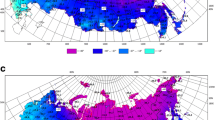Abstract
The study assesses the reliability of the description of hydrothermal conditions in the territory of Kalmykia with the use of quantitative climate indicators based on air-temperature and precipitation data that are available in databases and are widely used in climate models. The present study considers the use of the Selyaninov hydrothermal coefficient, the precipitation-evaporation coefficient, the Thornthwaite aridity index, the Köppen method, and the Holdridge scheme. Quantitative climate indicators were estimated for 1966–2017 based on data on the average monthly air temperature and total monthly precipitation at Yashkul’ weather station located in the Chernye Zemli strict nature reserve, which is the most arid part of the Republic. The estimated values of Selyaninov hydrothermal coefficient for the considered period corresponded to natural zones of deserts in two cases, semideserts in 19, and steppes in 31. With the precipitation-evaporation coefficient, the climate conditions corresponded to semidesert in 45 cases and steppe in seven. The values obtained with Thornthwaite aridity index were inherent for deserts and hyperarid regions. According to the Holdridge scheme, the hydrothermal conditions matched steppe zones in 25 cases and deserts in 27. The reliability is highest for climate assessments produced with the involvement of Selyaninov hydrothermal coefficient, which indicate humid warming in Kalmykia and are supported by material collected via the observation of plant communities that form on the ameliorated lands of Priergeninskaya Plain. The presence of humid warming is also supported by estimates based on the Köppen method, the Holdridge scheme, and, to a lesser degree, the precipitation-evaporation coefficient. The assessment involving the Thornthwaite aridity index points to an intensified climate aridization, which is not in line with the modern dynamics of climate conditions in Kalmykia and is thus not reliable.






Similar content being viewed by others
REFERENCES
Budagovskii, A.I., Isparenie pochvennoi vlagi (Evaporation of Soil Moisture), Moscow: Nauka, 1964.
Budyko, M.I., Teplovoi balans zemnoi poverkhnosti (Thermal Balance of the Earth’s Surface), Leningrad: Gidrometeoizdat, 1956.
Bulygina, O.N., Razuvaev, V.N., Korshunova, N.N., and Shvets, N.V., RF Inventor’s Certificate no. 2015620394, 2019a. http://meteo.ru/data/158-total-precipitation# oпиcaниe-мaccивa-дaнныx. Accessed September 4, 2019.
Bulygina, O.N., Razuvaev, V.N., Trofimenko, L.T., and Shvets, N.V., RF Inventor’s Certificate no. 2014621485, 2019b. http://meteo.ru/data/156-temperature#oпиcaниe-мaccивa-дaнныx. Accessed September 4, 2019.
Cherenkova, E.A. and Shumova, N.A., Evaporation in quantitative climate indices, Arid. Ekosist., 2007, vol. 13, nos. 33–34, pp. 57–69.
Drozdov, O.A., Vasil’ev, V.A., Kobysheva, N.V., Raevskii, A.N., Smekalova, L.K., and Shkol’nyi, E.P., Klimatologiya (Climatology), Leningrad: Gidrometeoizdat, 1989.
Ekologicheskaya entsiklopediya, G–I (Ecological Encyclopedia, G–I), Moscow: Entsiklopediya, 2010a, vol. 2.
Ekologicheskaya entsiklopediya, I–M (Ecological Encyclopedia, I–M), Moscow: Entsiklopediya, 2010b, vol. 3.
Guidance for Vulnerability and Adaptation Assessments: US Country Studies Program, Washington, DC: US Country Stud. Manage. Team, 1994.
Handbook of drought indicators and indices, 2016. https:// www.droughtmanagement.info/literature/WMO-GWP-Drought-Indices_ru_2016.pdf. Accessed February 15, 2021.
Holdridge, L.R., Simple method for determining potential evapotranspiration from temperature data, Science, 1959, vol. 130, p. 572.
Holdridge, L.R., Life Zone Ecology, San Jose: Trop. Sci. Center, 1967.
Ivanov, N.N., Moisture zones of the world, Izv. Akad. Nauk SSSR, Ser. Geogr. Geofiz., 1941, no. 3, pp. 261–288.
Khromov, S.P. and Mamontova, L.I., Meteorologicheskii slovar’ (Meteorological Dictionary), Leningrad: Gidrometeoizdat, 1974.
Novikova, N.M., Volkova, N.A., Ulanova, S.S., and Chemidov, M.M., Change in vegetation on meliorated solonetcic soils of the Peri-Yergenian Plain over 10 years (Republic of Kalmykia), Arid Ecosyst., 2020, vol. 10, no. 3, pp. 194–202.
Selyaninov, G.T., Agricultural assessment of climate, Tr. S-kh. Meteorol., 1928, no. 20, pp. 165–177.
Selyaninov, G.T., Principles of agroclimatic zonation of USSR, in Voprosy agroklimaticheskogo raionirovaniya SSSR (Agroclimatic Zonation of USSR), Moscow: Minist. Sel. Khoz. SSSR, 1958, pp. 7–14.
Shumova, N.A., Estimation of the accuracy of a model for calculation of soil water storage dynamics, Russ. Meteorol. Hydrol., 2003, no. 10, pp. 65–72.
Shumova, N.A., Assessment of vulnerability of hydrothermal conditions and zonal borders of arid areas at different probable climate changes, Arid. Ekosist., 2007, vol. 13, no. 32, pp. 34–46.
Shumova, N.A., Zakonomernosti formirovaniya vodopotrebleniya i vodoobespechennosti agrotsenozov v usloviyakh yuga Russkoi ravniny (Water Consumption and Availability of Agrocenosises of the South of Russian Plain), Moscow: Nauka, 2010.
Shumova, N.A., Analysis of climatic conditions in the Republic of Kalmykia for 1966–2017, Arid Ecosyst., 2020, vol. 10, no. 3, pp. 188–193.
Thornthwaite, C.W., An approach toward a rational classification of climate, Geogr. Rev., 1948, vol. 38, pp. 55–94.
Vysotskii, G.N., Izbrannye trudy (Selected Works), Moscow: Sel’khozgiz, 1960.
Funding
This work was carried out as a part of the State Assignment section 2.6, “Evolution of Terrestrial Ecosystems under Changing Natural Conditions,” of the research and development topic of the Institute of Water Problems, Russian Academy of Sciences, “Simulation and Prediction of Water Reclamation Processes and Ecosystem Rehabilitation under Various Scenarios of Climate Change and Anthopogenic Activity,” project no. 0147-2018-0002, state reg. no. АААА-А18-118022090104-8.
Author information
Authors and Affiliations
Corresponding author
Ethics declarations
Conflict of interests. The author declares that she has no conflict of interests.
Statement on animal welfare. This article does not contain any studies involving animals performed by any of the authors.
Additional information
Translated by E. Kuznetsova
Rights and permissions
About this article
Cite this article
Shumova, N.A. Quantitative Climate Indicators Applied to the Assessment of Hydrothermal Conditions in the Republic of Kalmykia. Arid Ecosyst 11, 327–336 (2021). https://doi.org/10.1134/S2079096121040120
Received:
Revised:
Accepted:
Published:
Issue Date:
DOI: https://doi.org/10.1134/S2079096121040120




